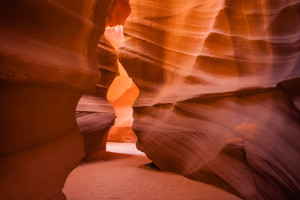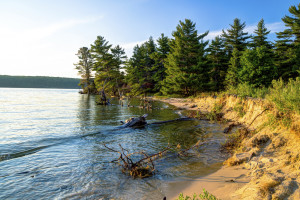Building Climate Resilience in Native American Communities

In the Navajo Nation, electricity may be a fragile commodity as climate change intensifies. Other tribes in the United States face similar energy quandaries. The United States Department of Energy (DOE) announced on Sept. 2 that it is requesting applications to co-fund renewable energy, energy efficiency, and combined heat and power to help increase the climate resilience of indigenous communities. The available funding is estimated to total around $4-6 million. Applications are due by Dec. 10.

For facility-scale installations, the amount of the source energy that must be displaced is 20 percent – and for renewable energy and/or combined heat and power, projects should produce at least 10 kW, said Lizana Pierce, project manager at DOE’s Office of Indian Energy. For community-scale installations, there is no minimum source-energy percentage, but the renewable energy and combined heat and power system must produce at least 50 kW.
These grants could prove to be quite valuable for local energy reliability. Native communities “spend a lot of time trying to obtain resources,” said William Smith, an anthropology professor from the University of Nevada, Las Vegas. (Smith participated in a video interview about his research on climate change’s effects on Native American communities in Nevada.)
According to a September DOE report, “Tribal Energy System Vulnerabilities to Climate Change and Extreme Weather,” climate change can cause droughts, heat waves, wildfires, permafrost unreliability, warmer weather, and erosion. It can also increase the intensity of floods, storms and downpours.
This unnerving list of risks varies based on geography. The report details a region-by-region breakdown of climate impacts on tribal lands, providing concrete examples of risks that communities already face. It covers all tribal lands and Alaskan native villages in the continental United States.
Some climate-related impacts can be softened through local resilience strategies. For example, air conditioning expenses can be lowered substantially. This is a key consideration for communities facing economic hardship and high electricity or fuel costs. Clean energy can also help to shield indigenous communities from the effects of fuel-supply disruption.
However, intensified storms, coastal and riverbank erosion, ice-melting patterns, heavy rainfall, and permafrost damage are all due to the large-scale effects of climate change. So they cannot be entirely addressed by the clean-energy interventions outlined in this grant. Energy-resilience measures can help to reduce the likelihood of blackouts, but they cannot address these issues comprehensively.
The report does not propose any specific responses for these weather-related hazards.
Additional funding for climate-impact resilience could help communities respond to the imminent challenges that local clean energy cannot solve.
Saving the Power Grid
Basic infrastructure on tribal lands is vulnerable to climate-induced damage.
How fragile are these community resources? More than one might think on casual observation.
One example the report outlined is from the Southwest. Climate change can cause heat waves, wildfires, and severe storms, all of which might put electric service at risk in the Navajo Nation. The reservation uses electricity to power its fuel-transport equipment. Electric pumps move crude oil through the Running Horse Pipeline, which is owned by the Navajo Nation. Electricity also enables the Black Mesa and Lake Powell Railroad to bring coal to the Navajo Generating Station.
There are two thermoelectric power plants on the reservation. These plants require cooling water from Lake Powell and the San Juan River. And their water supply and temperature can be affected by climate change, which leads to droughts and increases hot weather.
These power plants also operate two massive irrigation systems that deliver water to regional tribal lands.
Keeping Energy Affordable
Rate increases can also be harmful to tribal communities, so taking proactive steps to bring in renewable energy, cogeneration, and energy efficiency can help to avert the blow of increased costs.
At the end of 2014, the report said, residents of the Sault Sainte Marie Reservation in Michigan’s Upper Peninsula found that an electricity rate increase to cover power plant upgrades raised their monthly bills by 30 percent.
The Sault Tribe of Chippewa Indians said the effects would be “devastating,” according to the report.
Energy efficiency, distributed renewable energy, and cogeneration can all assist in lowering the cost of electricity in tribal communities.
The report said Alaska’s situation is particularly acute. In rural areas, native villages use diesel generators, which can be expensive to operate. The cost of diesel varies substantially, causing unexpected economic challenges for these small communities.
Native villages in Alaska receive diesel via barge or airplane. Airplane shipments are particularly costly.
Responding to Winter Storms
Constructing wind power installations can help to reduce the cost of energy in rural Alaska, the report said, but wind turbines are affected by the harsh storms in coastal areas. These storms may become more intense due to climate-related variability. This results in ice buildup on the turbines. Sometimes, the turbines may even send ice flying into the air. Ice can also put rotor blades out of balance and even bring down measurement towers.
In 2011, a coastal storm ruined the Alaska Village Electric Cooperative’s new power transmission intertie before it was ever put into use, the report said. The cooperative was not able to repair the intertie before another coastal storm damaged it in 2013.
Ice and snow can also overload power lines in Alaska, causing poles to snap, the report said. Power lines covered with ice may also vibrate violently during high winds. After the ice melts, the lines may rebound and make contact with trees.
Adjusting to Permafrost Failures and Ice Jams
The report also described how permafrost weaknesses and ice jams can create electrical and fuel hazards in Alaska.
Permafrost problems due to climate change can cause power poles to tip or sag. The poles may also be lifted up by frost jacking. Permafrost failure can also affect other distribution and grid equipment.
Air transport runways used for fuel shipments can also be damaged by unreliable permafrost.
Ice jams along rivers can flood native villages in Alaska unexpectedly. A Yukon River ice jam destroyed 90 percent of the structures in the village of Galena in 2013. Fuel-storage tanks were knocked over and sometimes leaked into the river. Two other communities were also threatened.
Preparing for Floods
Climate change also leads to riverbank and coastal erosion, particularly in Alaska. Because the bank of the Koyukuk River is eroding rapidly, a power plant has been relocated inland.
In the Northwest, flooding may disrupt inland power plants serving tribal lands. Four power plants in the Puget Sound region are under four feet above sea level and may be damaged by waves or storm surges.
Extinguishing the Effects of Fires
Wildfires are also more common as climate affects average temperatures and causes droughts. These are becoming more frequent throughout the western United States – including Alaska.
In Alaska, wildfires can lead to unsafe conditions around fuel-transportation lines. In 2014, a wildfire near the Trans Alaska Pipeline System led to deployment of water trucks, sprinkler systems, and bulldozers.
Soot, heat and smoke from wildfires can cause widespread disruption of electricity service in rural areas, including on tribal lands and in native villages.
Note: Lizana Pierce edited the information in her quote on 10/13/2015.
Join our LinkedIn group to discuss this article. You may also email the author directly using our contact form.

